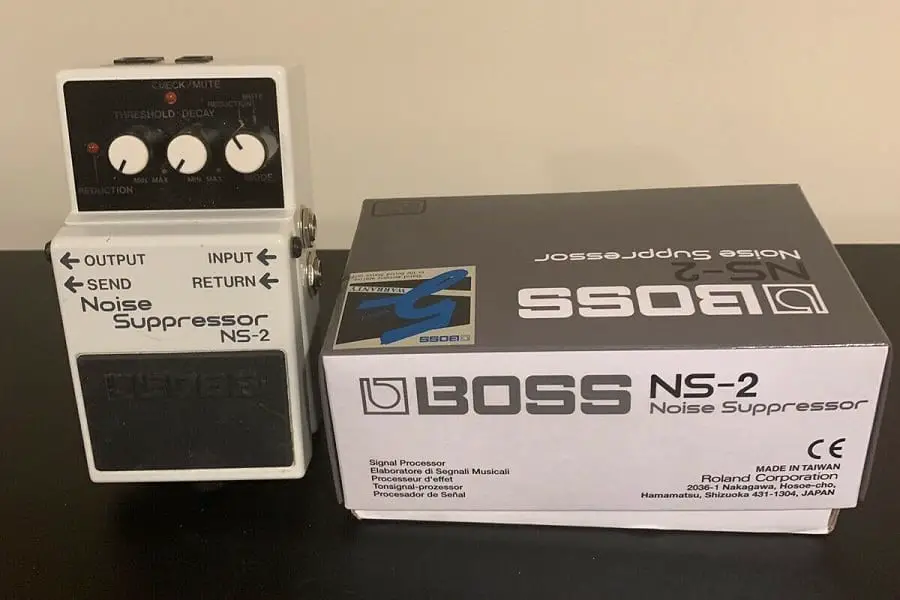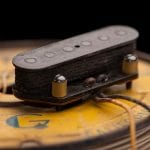Since this is the 21st century, there is a whole range of available guitar effects pedals on the market.
Some of them are more popular than others, while some of them are obscure and you won’t even see them being used in this day and age.










However, some of the seldomly used pedals are the most useful tools a good guitar player needs and should have in his or her pedalboard.
Noise gate pedals belong to this niche group. Although they are seldomly used or even seen being used, they play a crucial role when it comes to guitar effects. These effects pedals are responsible for eliminating the amp pedalboard hiss.
There are lots of noise gate pedals out there and in the following guide we’ll take a look at some of the best on the market and why you should be investing in them.
Best Noise Gate Pedal Reviews For 2021
BEST Overall – BOSS NS-2 Noise Suppressor/Power Supply Pedal
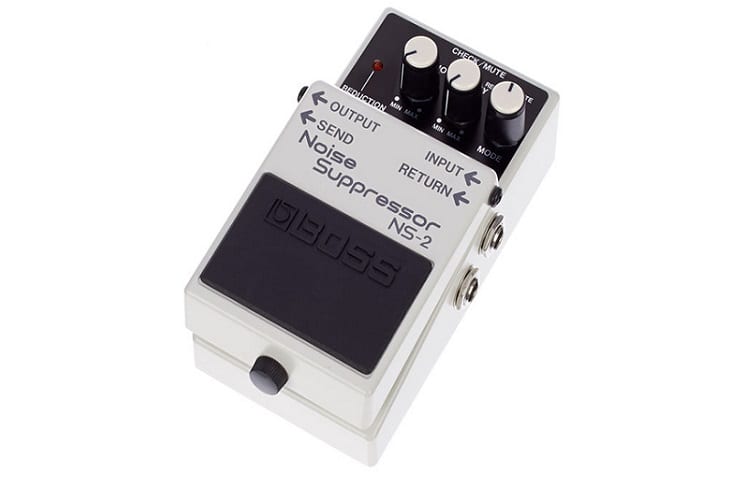
Boss is a reputable company that makes high-quality products at affordable prices. It just happens that one of the most impressive products is the BOSS NS-2 Noise Suppressor Pedal and it is the best that anyone has seen in a while.
While the pedal has quite a good form and structure, the design also works in terms of reliability and durability. From the outside, it looks like any other noise suppressor, however, when you take a look under the hood, this is where you find the features and expert precision.
Controls are available in the form of three knobs. You won’t need to take much gain over the noise gate pedal which is a reoccurring theme in most models of this type.
So on this device, you’ll find a Threshold knob, and a Decaying knob, and these two controls allow you to dial in precisely when the noise gate will kick in and also determines how sensitive the pedal will be. The third knob has two modes labeled mute and reduction.
When it comes to precision, there is no better way to describe it. The Threshold control is very sensitive and it takes a learning curve. However, it allows you to dial in and hit the sweet spot each and every time.
If you dial everything according to your gear then you won’t have to worry about feedback ever again. The pedal doesn’t affect the color of your tone, volume or any other aspect.
So to sum it up the Boss noise suppression pedal is designed for eliminating hum and noise in guitar, bass, and amplifier setups. The noise detection circuit preserves the natural attack and envelope of an instrument sound and the threshold and decay knobs allow for shaping the suppression as desired.
Pros:
- Compact
- eliminates noise in guitar, bass and amplifier
- 5 year warranty
Cons:
- Cuts in to the top end of your tone
Runner Up – MXR M135 Smart Gate Noise Pedal
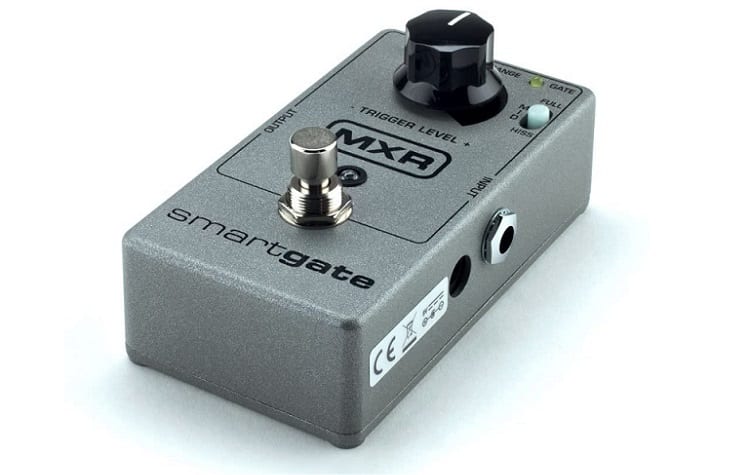
When it comes to some of the best pedals on the market, the MXR M135 Smart Gate Noise Gate is probably one of the most impressive noise gate models compared to other elite models.
The performance was developed in a bit more complex way and the housing of the pedal is standard MXR stuff, which is basically a rugged enclosure and though the design is quite basic, the durability is constant and incredible.
Aside from being able to adjust to the threshold of the gates, there are three modes of operation in this noise gate, Hiss, Full, and Mid respectively. When you select Hiss, the pedal eliminates the extraneous hiss.
When you select Mid, this is where the gate effect is increased but not fully present, and finally, Full mode is just standard noise gate mode.
Like most of the noise gates control pedals, this one comes with threshold control that allows you to dial in the exact volume where the pedal kicks in.
The modes are all controlled by a single three-way switch that is situated in the upper right-hand corner of the pedal. Right across from it is a switch labeled Hi Trigger Range. Once activated, the pedal becomes a lot more precise in the given volume band.
This noise gate pedal is not the most complex one out there, however, it’s still not the most basic one as well. Some of the standard features that are used or implemented in this noise gate are practical ones that can be used on a daily basis.
The performance is otherwise solid, which is what matters the most at the end of the day. The pedal also tracks well and the addition of several modes of the operation increases its versatility when combined with different setups. That in itself makes it one of the best pedals on the market.
So to sum it up, this noise gate pedal has three selectable noise reduction ranges, and it reacts gradually to long, sustained notes and quickly to short and syncopated ones. Fast attack time reserves picking transients and harmonic overtones and it features a hardwire bypass, clean circuitry, and precise threshold trigger.
Pros:
- Three noise reduction ranges
- Fast attack time
- Hardwire bypass available
Cons:
- Not long lasting
Alternative – TC Electronic Sentry Noise Gate Pedal
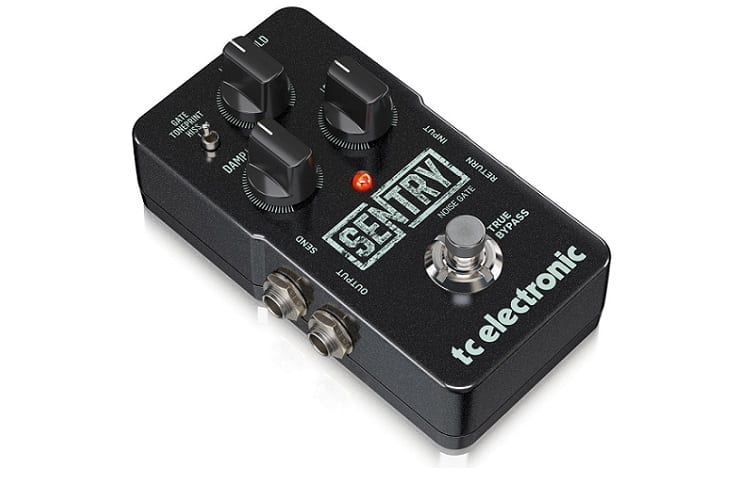
Sentry noise gate is your ticket to a noise-free and fully dynamic performance. The state-of-the-art multiband technology is developed to cater to all your buzz and hum killing needs and with its highly intuitive design, you will be dialing out that unwanted noise in no time at all.
This high-quality multiband noise gate pedal has an impressive hard gate mode for noise-free dynamic performances. The classic hard gate mode gives you instant noise removal and you can send the loop for patching noisy pedals through or creatively sidechain for other audio signals.
Thanks to the true bypass, it allows for optimum clarity and zero high-end loss when the pedal is off. There is an optional buffet bypass mode which prevents high-frequency loss from long cable runs. Overall speaking its simple, easy to use controls let you focus on playing while the pedal takes care of the rest.
Ultimately, the multiband technology houses one of the most advanced noise removal algorithms to this day. It enables you to hone in on specific frequencies and quickly remove extraneous noise from your signaling as you stop playing and it does it all without compromising your core tone. So the end result is the most seamless and organic noise reduction you have ever experienced.
It is also silent and features a classic hard gate mode which can be used for immediate noise cut effect. So you can go from a full sonic barrage to dead silence in a split second. It also features TonePrint meaning signature effects and this ultimately means truly creative tones.
Music ultimately is the most important expression of yourself and this is why you have the right to have effects, the way you want it. With this noise gate pedal, you’ll be able to achieve this and much more.
Pros:
- Cutting edge multiband and hard noise gate modes
- Tone Print enabled
- True or buffered bypass available
Cons:
- Gate cuts in and out intermittently
Alternative – ISP Technologies Decimator II Noise Reduction Pedal
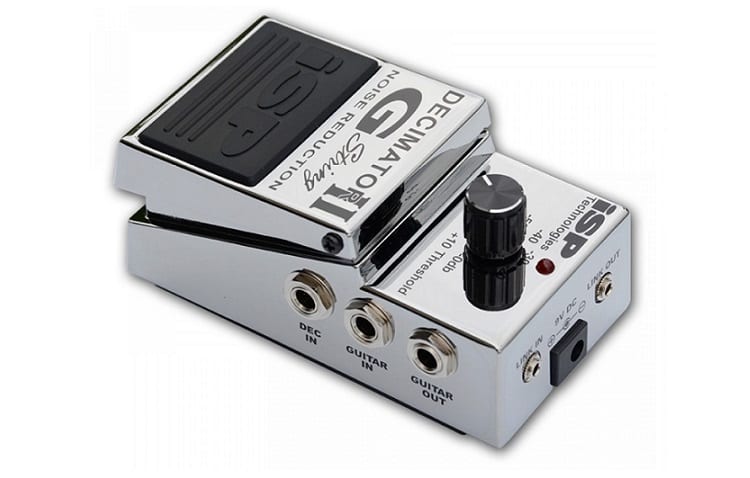
This ISP Technologies Decimator II Noise, when it comes to durability is on the same level with Boss pedals, if not slightly better.
It has an unfinished metallic look which gives it’s quite an edgy aesthetic appearance as compared to other models on the market. The ability of this pedal to be used as an effects loop or to add a processing channel into the said loop is basically what sets it apart from other models.
You also get a set of inputs and outputs which can be used to link to these pedals in a chain. These are definitely significant features although they may only appeal to a niche group of users.
When it comes to the Decimator, there is only one knob to work with. It allows you to adjust the volume level when the noise kicks in. On one hand, this approach might seem quite basic, however, this is plenty enough for those who know exactly where they want the noise to disappear.
The circuitry on this device is a piece of art. It may seem basic on the outside, however, the pedal brings all the features we mentioned along with a pretty bulletproof signal path that doesn’t alter your tone in any way, form or shape.
This applies to situations where the pedal is turned on or off. Dialing in the volume level is also simple and the indicator is precise.
Pros:
- Tracks the guitar signal directly from the guitar
- Includes link in and link out feature
- Processing channel can be inserted into your effects loop
Cons:
- Works intermittently
Alternative – CNZ Audio Noise Gate Pedal
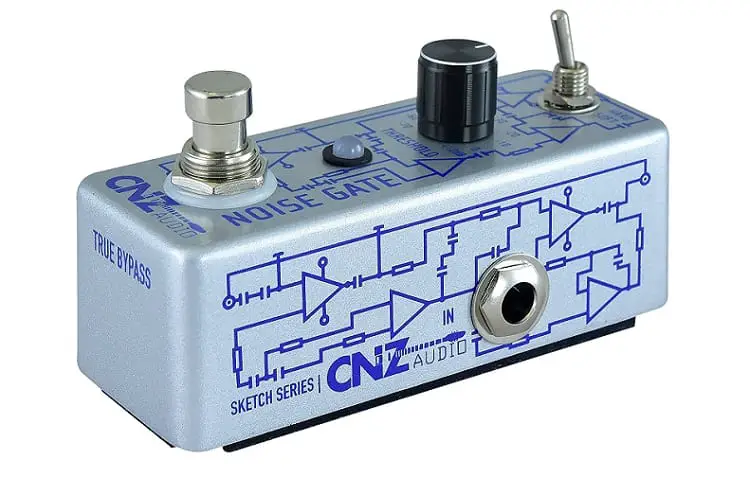
The CNZ Audio Noise Gate – Guitar Effects Pedal tames your guitar signal, overdrive pedals and the entire effects chains. This device is ideal for trying to reduce hum in your signal while you’re not playing.
The toggle switch has two settings and that is “hard” and “soft”. The hard switch adjusts the pedal so its release is almost instant.
The hard switch also eliminates unwanted noise and creates clean silencing between the notes of a heavy metal riff. The soft setting eases up on the release and allows it to end in a less abrupt manner. When the pedal begins cutting off the signal, this is when the threshold knob starts adjusting.
If you set the knob to -30 DB, the pedal will cutt off at any signal that is lower in that value. When you set the potential to higher values like +10, it can create some heavy distortion and reverb. The true bypass footswitch allows for the tone to come through the pedal unaffected in the “off” position.
Pros:
- Has toggle switch with two settings
- Threshold knob adjust when pedal begins cutting off signal
- True bypass footswitch available
Cons:
- Not the best quality
Noise Gate pedals FAQ
What does a noise gate pedal do?
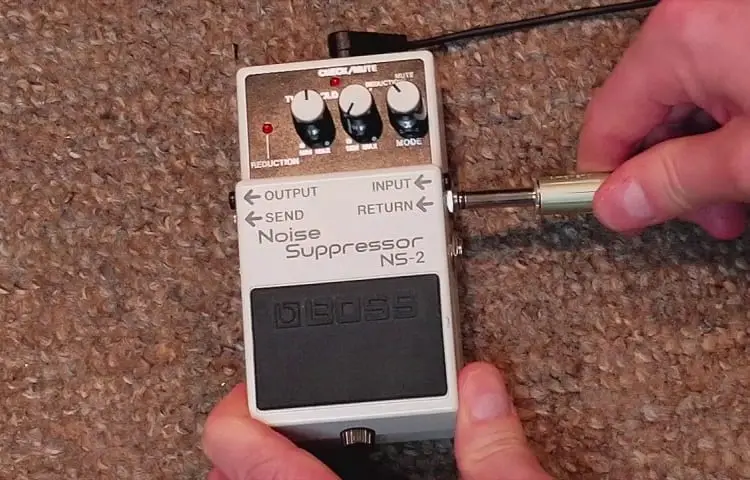
Some guitar players use a high gain amp or play single-coil pickups and this causes unwanted buzz and hum and while they are playing. A noise gate is the most popular solution to unwanted guitar noise.
Most people have at some point in time experienced unwanted noise from an amplifier. It’s probably one of the most annoying parts of being a musician and that pestering buzz produced by the amplifier can tend to drive people crazy.
However, one of the most common and practical solutions is the noise gate pedal. It will attenuate a signal that drops below a certain threshold in-between chord stabs, licks, and riffs and cut your signal to prevent that annoying hum.
The following guide will take a look at some of the potential causes of this annoying hum, how a noise gate can help, and the different options on the market when it comes to noise gate pedals.
Is a noise gate pedal necessary?
There are many reasons why a noise gate pedal is necessary in your signal chain. First and foremost, it is a tool, but it is a crucial one. Noise gate pedals have pretty basic applications, however, these pedals have their purpose in quite complex situations as well.
People that are interested in this type of effect pedal are those who place a lot of emphasis and value on their tone in a very specific type of way.
Those who are involved in heavy metal music or similar styles or genres won’t see much benefit in having a noise gate pedal, however, once you step into the genres where subtle touches are key, it is a whole new ballgame.
If you have complicated pedalboards, it could create problems. Linking a large number of pedals together has its benefits, however, it can have its flaws as well. When there are too many circuits being used by a huge amount of cables it’s bound to bring about some unwanted noise in your signal.
However, once it reaches the amp, the tone will be altered in a way that creates noise. If you are simply playing at home, or in your local studio then it may not be much of a dealbreaker, however, once you hook up to professional stage setup, the noise gets amplified exponentially.
And this is where having a decent noise gate pedal eliminates that issue quickly and efficiently.
Where should a noise gate pedal go?
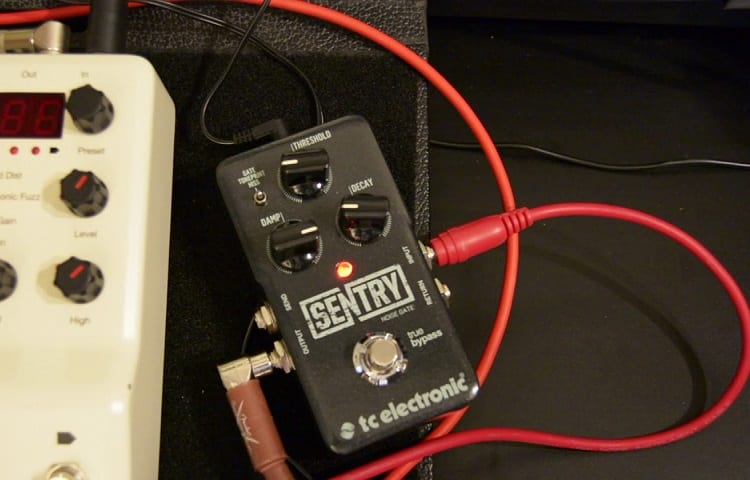
Even though most noise gate pedals have two relevant knobs at best, it does not indicate that adjusting them is easy. In fact, the opposite is true. There are a lot of things to consider when tweaking a noise gate pedal.
This is the case even if you have the best one on the market because it won’t help you much if you don’t know how to use it.
You need to begin with the Threshold. Then knob sets the cutoff volume level where the pedal will kick in and attenuate everything. So the Threshold needs to be fine-tuned to the extent where it kicks in to deal with the noise but doesn’t cut off the soft notes. Doing this and getting it right does take time, effort and a lot of troubleshooting.
The next thing you need to consider is Decay. Decay determines how fast the noise gate kicks in when you reach the selected threshold. Your tone will be clean, but choppy and unnatural if you set a fast Decay.
Then again, if you set in a slow Decay, the probability is that the noise gate won’t even work half of the time. The truth is there is no silver bullet formula and this is mainly because every setup is different.
So everyone will have to deal with that on their own. The best way to get the setup right is to play with the standard highest and lowest intensity. Once you figure that out, set the threshold appropriately and then deal with the Decay.
Ultimately, placing a noise gate pedal in the signal chain comes down to two options. If you are not using reverb or delay go for the end of the chain. However, if you are, then place the noise gate before these effects, or else it will interfere with their performance.
Some users like to put the noise gate after their high gain pedals such as distortions and overdrives. This way the pedal kicks in to deal with the noise created by these effects when a lot of gain is pushed into the signal.
What is the difference between a noise gate and a noise suppressor?
Noise suppressors filter out certain frequencies and noise gates completely cut off the signal at a point selected by the user. Noise gates are more effective because most of the time the noise in the signal chain is coming from dirt pedals.
Noise gates can also make things sound more professional because when you stop playing everything stops and that’s how it is on most songs you listen to.
So there is no terrible guitar white noise or buzz in the background when you listen to songs on the radio. However, not all noise gates are made the same. Some of them have better response times and lower tone suck.
Some are slow opening and closing the gate so there is always a small annoying waiting for it to happen. Noise gates also work best after your dirt pedals but before your delay pedals.
Conclusion
Noise gates are used to sort out some annoying guitar issue each and every day and some that require a bit of creativity.
However, a noise gate pedal is something that you won’t necessarily notice when it’s doing its job but should definitely notice when it isn’t there. So the best thing about this effects pedal is that you can get one at an affordable price.
A cheap one will not necessarily have all of the bells and whistles, but It will still give you that core performance and that’s the most important part.
Most people won’t see many noise gate pedals being used in their environment. This is mainly because it’s considered extreme in the sense of tone optimization and shaping. However, as soon as you get to experience one of these pedals and hook it up to your rig, you’ll start wondering how you managed so long without it.
As with everything in life, skill does come with experience, however, there is no reason for even a new guitar player not to be aware of an awesome tool like a noise gate pedal. If you’re still not convinced of whether you need a noise gate pedal or not, test one out at the local guitar shop and then consider your thoughts.


